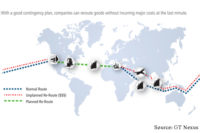Manufacturing News
Connected, secure automation yields positive results

“Technology is widely recognized as one of the biggest enablers, but [is] also disruptive. We have seen companies, and even countries, stumble because of the one technology that affects us all—cybersecurity,” said Peter Holicki in the opening keynote address of the ARC Forum. Holicki is Dow Chemical Company corporate vice president, manufacturing & engineering & EH&S.
“Technology needs strategy, and it needs business alignment, but most definitely, it needs business ownership,” added Holicki. Getting control of technology to accomplish business objectives was certainly a major concern at the conference, but the forum devoted all day Monday, February 9 and additional sessions on Tuesday and Wednesday of that week to cybersecurity issues.
Participants from the Automation Federation, NIST, FBI, Exelon, US Department of Homeland Security and several other groups addressed the importance of protecting control systems from cyber attacks, understanding the risks and potential consequences of attacks, and the vulnerabilities of industrial control systems.
Other technical sessions at the ARC Industry Forum covered several issues in automation—such as successfully implementing automation, building a secure-by-design industrial Internet of things (IIoT), creating new analytics approaches for the IIoT, creating and sustaining a proactive culture in asset lifecycle management, maximizing benefits through control and information convergence, and getting results from enterprise manufacturing intelligence. Other sessions included operator training, plant design issues and smart field devices. An ARC study, “Overcoming Automation Challenges,” further outlined many of the issues the sessions addressed.
According to Craig Resnick, ARC vice president of consulting who chaired the session, “Use Enterprise Recipe Management to Quicken Production and Reduce Costs,” as the transactional-based side of an enterprise moves toward real-time information from the plant floor (often called convergence), a new system, known as enterprise recipe management, takes advantage of this convergence. Incorporating the methods used in enterprise recipe management can reduce manufacturers’ expenditures on multiple, incompatible databases that don’t communicate with one another, even though they may be employing ISA 88 and ISA 95 standards.
In fact, processors that use technology to make even small changes can reap definite rewards. For example, Darin Massner, Country Maid CEO, explains how implementing $8,000 worth of flow, level and pressure instrumentation and $2,000 for controls programming has saved his company $23,000 per year in plant waste. Country Maid, which makes laminated pastry dough with very tight quality specs, had several difficult-to-control variables in making each batch of dough including the temperature of the room, equipment, flour, water and resulting dough. “We were losing two to three batches every morning due to temperature issues,” says Massner.
“This is not a big-dollar example. We were more interested in shifting the mindset of our [operations and] maintenance staff and that of management,” says Massner. A little difference in manufacturing has made a big difference in the dough’s expected 15-month shelf life.
“We moved from a very manual operation to a somewhat highly automated solution. That was a real mindset shift for our operators who were handling bags of flour and, at the end of the day, counting the number of bags used to see if they used the correct amount,” adds Massner.
Based on data points collected from the instrumentation, and working with the trend data, the processor was able to fine-tune the process.
Key aspects in making new automation projects work in today’s IIoT world include using a new model for managing automation projects that requires early design involvement, coupled with modular and standard construction, for faster completions. Also important, in terms of I/O, hardware must be separated from software, allowing the software to be deployed into the hardware infrastructure at the very late stages of the project, often referred to as late binding. New approaches like these can reduce automation project execution times from 18 to 24 months to just 12 months, according to ARC.
For more information: www.arcweb.com, 781-471-1000.
Looking for a reprint of this article?
From high-res PDFs to custom plaques, order your copy today!






